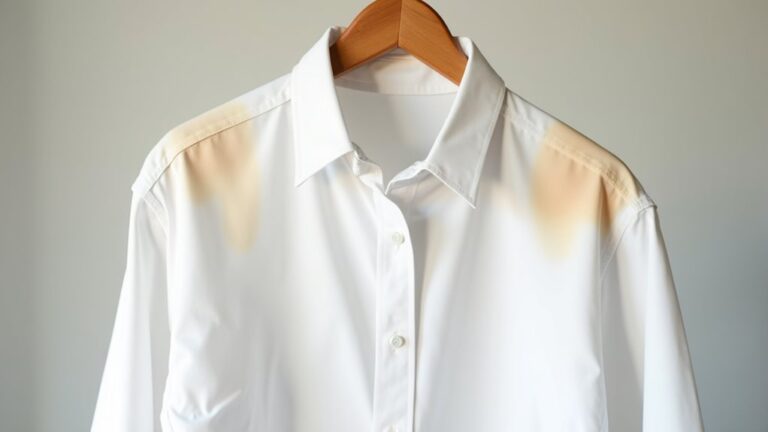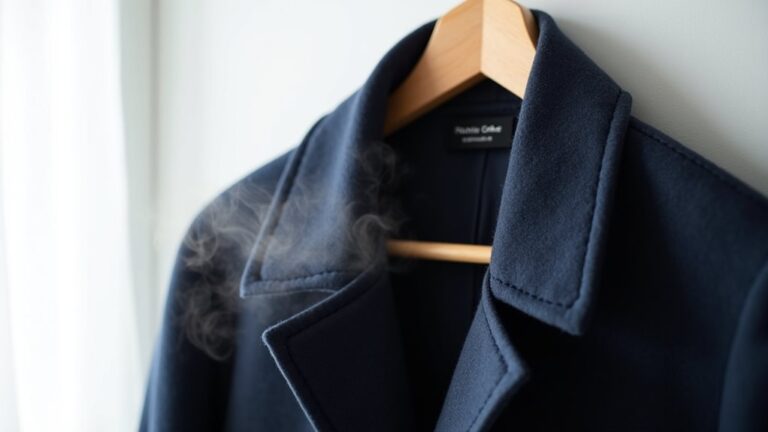Dry cleaning can tackle many stubborn odors that regular washing can’t touch, especially oil-based smells like cooking odors, cigarette smoke, and certain perfumes. The specialized solvents dissolve these embedded scents without using water, which makes it perfect for delicate fabrics. However, you’ll find that some deeply saturated odors, particularly from heavy sweating or synthetic materials, might persist even after professional cleaning. If you’re dealing with particularly stubborn smells, there are additional strategies worth exploring.
How Dry Cleaning Works to Remove Odors
When you drop off that favorite blazer that somehow absorbed every aroma from last night’s barbecue joint, you’re probably wondering if dry cleaning can actually rescue it from smelling like a smokehouse forever.
Here’s the reassuring truth: your dry cleaner works like a scent detective, using specialized solvents such as perchloroethylene to dissolve those stubborn oil-based odors that water simply can’t touch.
During the dry cleaning process, your garments tumble in these powerful solvents, which penetrate deep into fabric fibers and lift out embedded smells that regular washing leaves behind.
While you might notice a slight chemical smell initially, it dissipates quickly, leaving you with genuinely clean garments that smell fresh rather than masking odors with artificial fragrances.
This makes dry cleaning particularly valuable for delicate fabrics and formal wear that require gentle yet effective odor removal without the risk of damage from water-based washing methods.
Types of Smells Dry Cleaning Can Eliminate
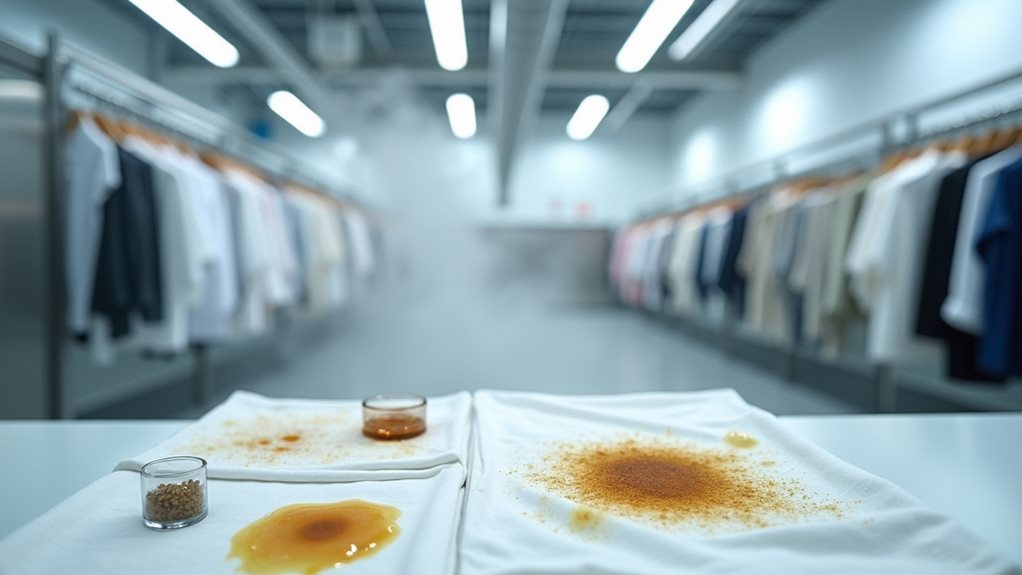
Now that you understand how dry cleaning’s detective work happens behind the scenes, let’s talk about which specific smells will actually wave the white flag when faced with those powerful solvents.
These industrial-strength solvents act like molecular bounty hunters, tracking down and eliminating even the most stubborn odor molecules hiding deep within fabric fibers.
You’ll be amazed at what dry cleaning can tackle – cigarette smoke that’s haunted your favorite blazer, cooking odors that somehow migrated from kitchen to closet, and even that musty mildew scent from storing clothes in less-than-ideal conditions.
The solvent used in professional cleaning uses specialized chemistry to penetrate deep into fabric fibers, making it particularly effective against oil-based perfumes and sweat odors.
However, I’ve learned the hard way that some stubborn smells require pre-treatment, and occasionally, certain deep-seated odors might need multiple rounds to completely remove.
Smoke particles are particularly challenging because they penetrate fabric fibers so deeply, but dry cleaning’s chemical solvents like perchloroethylene can dissolve these stubborn odor compounds more effectively than regular washing.
Why Some Odors Persist After Dry Cleaning
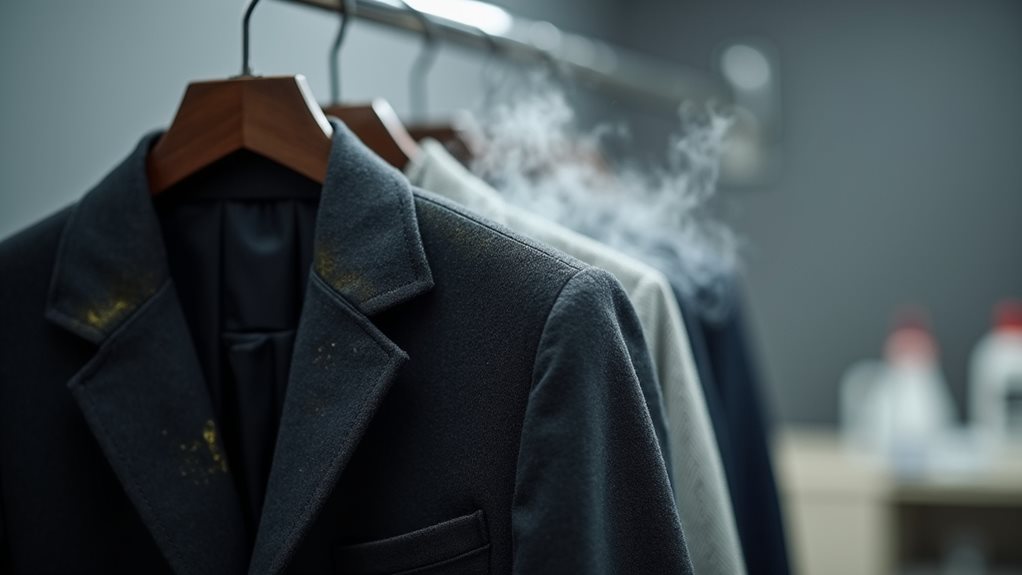
You’ve probably experienced that disappointing moment when you pick up your favorite shirt from the dry cleaner, only to catch a whiff of that stubborn smell that somehow survived the process 😕.
The truth is, the solvents used in dry cleaning have their limitations when it comes to certain types of odors, and some fabrics practically hold onto smells like they’re precious memories.
When odors have deeply saturated the fibers over time, especially from things like heavy sweating or cooking smoke, they can embed themselves so thoroughly that even professional cleaning struggles to reach them completely.
Additionally, garments that haven’t been properly processed through the final drying cycle may retain chemical solvent odors that require additional airing time to dissipate completely.
Solvent Limitations on Odors
Although dry cleaning works wonders on many stubborn stains, I’ve learned the hard way that it’s not the miracle solution for every odor that plagues our favorite garments.
The culprit lies in how these solvents dissolve different types of substances – they’re incredibly effective at removing oil-based stains and their associated smells, but they stumble when facing water-soluble odors like sweat, perfume, or that lingering garlic from last night’s dinner 😅.
I’ve discovered that natural fibers like wool and silk respond much better to dry cleaning’s odor-fighting abilities than synthetic materials, which seem to grip onto smells with surprising tenacity.
Understanding these limitations has saved me from repeatedly dropping off the same musty blazer, expecting different results each time.
Sometimes the dry cleaning process itself can introduce odors, particularly when perchloroethylene (PERC) solvent doesn’t fully evaporate from garments, leaving behind that distinctive sharp chemical smell.
Fabric Type Matters
The fabric itself plays a starring role in this odor drama, and I’ve watched certain materials practically laugh in the face of even the most thorough dry cleaning treatments.
Your fabric type determines whether you’ll walk away smelling fresh or still carrying yesterday’s mistakes, and honestly, some natural fibers are just stubborn little rebels.
When you’re dealing with dry cleaned clothing, understanding these material quirks can save you from disappointment and wasted money on repeat cleanings that won’t solve your odor problems.
Professional cleaners often use ozone chambers specifically designed to neutralize the most stubborn odors that regular solvents can’t eliminate.
- Natural fibers like wool and silk trap odors more aggressively than synthetic materials
- Heavy fabrics absorb smells deeper, making removal nearly impossible sometimes
- Suede and cashmere require specialized care beyond standard dry cleaning methods
- Porous textures create perfect hiding spots for persistent odors
- Food and pet scents often outlast even professional cleaning attempts
Deep Saturation Issues
When odors penetrate deep into fabric fibers, they create what I like to call “molecular squatters” that refuse to budge even after professional cleaning. I’ve learned this lesson the hard way through countless disappointed trips back from the dry cleaner.
These deeply embedded odors, especially from sweat or spilled curry 🍛, become so saturated within the fabric that standard solvents can’t reach them effectively. While natural fibers like wool typically handle cleaning better, even they struggle when oils have truly settled in.
You’ll find that synthetic fabrics are particularly stubborn about releasing these trapped smells. Sometimes multiple cleaning sessions become necessary, though honestly, pre-treatment with specialized products often works better than hoping dry cleaners can work miracles on your favorite stinky blazer.
Professional dry cleaners often have additional deodorizing treatments available beyond their standard chemical solvent process to tackle these persistent odor problems.
Limitations of Dry Cleaning for Odor Removal
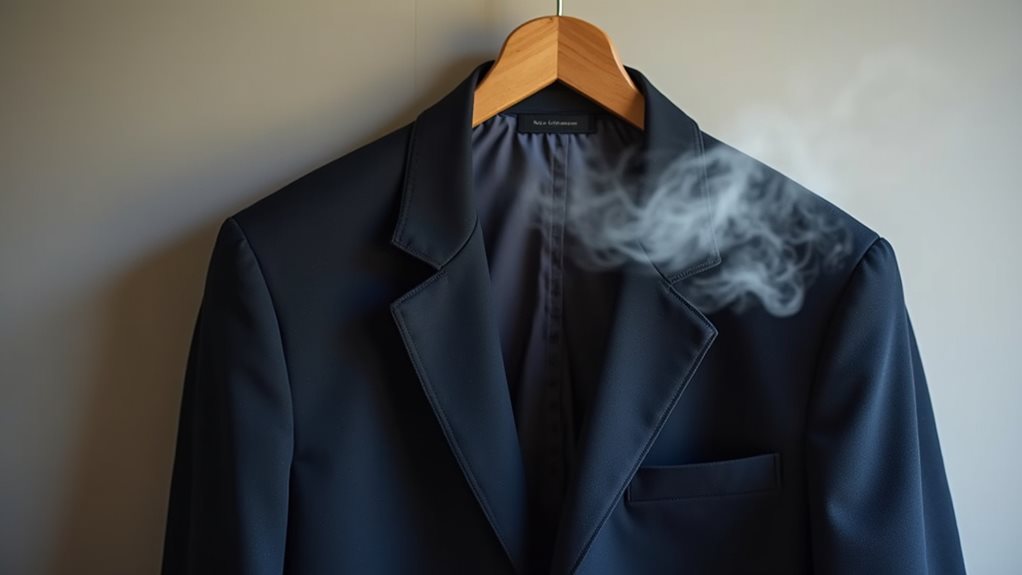
Despite its reputation as a miracle solution for fabric care, dry cleaning has some pretty frustrating blind spots when it comes to banishing stubborn odors from your favorite garments.
While dry cleaning offers excellent results for many stains, you’ll quickly discover that certain smells laugh in the face of professional treatment, leaving your clothes still smell-ridden despite the hefty price tag.
Here’s what dry cleaning struggles with most:
- Sweat and body odors that penetrate deeply into natural fibers like wool and silk
- Pet-related smells that cling stubbornly to fabric fibers
- Food aromas that resist standard cleaning procedures
- Oil-based stains requiring specialized pre-treatment before processing
- Deeply embedded scents that traditional washing might handle better
Sometimes you’ll need special treatments beyond standard procedures to achieve truly fresh results. Additionally, your dry cleaned clothes might actually develop unpleasant odors when cleaners use contaminated solvents or fail to properly separate heavily soiled items during the cleaning process.
Alternative Methods for Stubborn Smells

Since dry cleaning sometimes leaves you hanging with clothes that still carry unwanted aromas, you’ll want to explore some surprisingly effective DIY solutions that can rescue your favorite garments from the scent graveyard.
When dry cleaning betrays your wardrobe with lingering chemical odors, these clever DIY tricks will breathe fresh life back into your garments.
When that pesky dry cleaning smell lingers like an unwelcome houseguest, vinegar becomes your secret weapon – mix it with water for pre-treating stubborn spots, or use it in a steam treatment to neutralize chemical odors.
Baking soda works magic too; simply stuff a sock with it and seal everything in a garment bag overnight.
For coffee lovers, ground beans can remove odors without moisture damage.
Don’t underestimate fresh air either – hanging clothes near sunny windows creates natural ventilation that thick fabrics desperately need.
If these methods don’t work, consider switching to eco-friendly dry cleaners that use alternative solvents which are less likely to leave persistent chemical odors on your clothing.
Tips for Maintaining Fresh-Smelling Garments

You know, I learned the hard way that keeping clothes fresh isn’t just about emergency dry cleaning trips after my nephew’s spaghetti sauce incident 😅 – it’s really about developing smart habits that prevent odor problems before they start.
The three game-changers I’ve discovered are mastering proper storage techniques that actually protect your garments, learning simple pre-treatment methods that make cleaning more effective, and establishing a regular maintenance routine that keeps everything smelling great between wears.
Trust me, once you nail these basics, you’ll spend way less time worrying about whether that favorite blazer needs another expensive cleaning cycle, and you’ll feel more confident knowing your clothes always smell as good as they look. And while the chemical solvents and high temperatures in dry cleaning can eliminate many odor-causing bacteria, developing these preventive habits means you won’t have to rely on professional cleaning as your only solution.
Proper Storage Techniques
How many times have you pulled out a favorite jacket from your closet, only to be greeted by that telltale musty smell that makes you wonder if you’re housing a small swamp in your wardrobe? 😅
Trust me, I’ve been there, and proper storage techniques can save your clothes from becoming odor magnets.
The secret lies in creating the perfect environment where your garments can breathe and stay fresh, rather than developing those mysterious smells that seem to appear overnight.
- Store clothes in breathable garment bags or cotton covers instead of plastic
- Make certain garments are completely clean and dry before storage
- Use cedar blocks or lavender sachets for natural odor absorption
- Keep storage areas cool, dark, and dry
- Regularly air out stored clothing in well-ventilated spaces
If you’ve recently had items dry cleaned, allow freshly cleaned garments to air out completely before storing them to prevent residual chemicals from affecting the air quality in your closet.
Pre-Treatment Before Cleaning
Proper storage sets the foundation for fresh garments, but sometimes you’ll encounter stubborn odors that need a little extra attention before they head to the dry cleaner.
Pre-treatment becomes your secret weapon for effective odor management, especially when dealing with those “oops, I wore this blazer to three meetings in 90-degree weather” moments 😅.
For sweat-related smells, I’ve found that mixing equal parts water and white vinegar directly onto problem areas works wonders before professional cleaning.
Odor-neutralizing sprays can also tackle persistent scents that regular stain removal might miss.
The key is communicating with your dry cleaner about specific issues, since proper assessment helps them choose the right solvents that’ll penetrate deeper into fabric fibers for complete odor elimination.
Regular Garment Maintenance
While pre-treatment tackles immediate odor crises, maintaining fresh-smelling garments really comes down to developing consistent habits that prevent those “crisis moments” from happening in the first place.
Think of garment maintenance like brushing your teeth – it’s those daily choices that make the biggest difference. Regular washing between dry cleaning sessions helps remove odors before they settle deep into fibers, especially for items you wear frequently.
I’ve learned that dry cleaned clothes still benefit from proper storage and occasional freshening up.
- Schedule dry cleaning every few wears for service uniforms or workout clothes
- Hand-wash natural fiber garments prone to absorbing sweat and odors
- Apply odor-neutralizing products between cleanings to maintain freshness
- Store clothing in well-ventilated spaces, avoiding damp conditions completely
- Pre-treat stubborn smell areas before professional cleaning for better results


